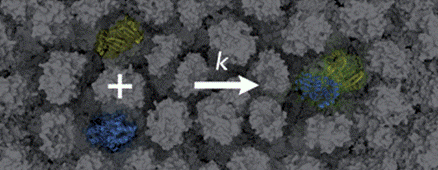| Search for content and authors |
Biologistics in bacteria: protein motion and gene regulation |
| Robert Hołyst |
|
Institute of Physical Chemistry Polish Academy of Sciences (IPCPAS), Kasprzaka 44/52, Warsaw 01-224, Poland |
| Abstract |

Biologistics and biochemistry in a crowded environment are two emerging interdisciplinary fields of science. They provide quantitative analysis of mobility of proteins and their interactions involved in gene expression and regulation. I will discuss the mobility of small ligands, proteins and plasmids in cytoplasm of E.coli HeLa and Swiss 3T3 cells [1, 4] and in complex liquids [1-3]. I will explain why proteins move so fast in seemingly highly crowded environments (e.g. cell nucleus, mitochondria or cytoplasm of bacteria). Most proteins (of sizes below 5 nm) have the same mobility in the cytoplasm of eukaryotic cells as in water [1]. Therefore their association rate does not differ much from the one measured in vitro (in a buffer) [5, 6]. For the first time such association of two freely diffusing proteins in a cytoplasm of HeLa cell was measured in 2012 [6]. I will also provide specific-site searching time for 180 known transcription factors in E.coli and discuss the results from perspective of facilitated target location and mobility in living cells [4, 7, 8, 9, 10]. Finally I will give a simple prescription for quantitative analysis of interactions between proteins and macrostructures inside living cells based on their mobility data [10]. References: [1] T. Kalwarczyk et al, Comparative Analysis of Viscosity of Complex Liquids and Cytoplasm of Mammalian Cells at the Nanoscale Nano Letters 2011, 11, 2157 |
| Legal notice |
|
Presentation: Invited oral at IX Multidyscyplinarna Konferencja Nauki o Leku, by Robert HołystSee On-line Journal of IX Multidyscyplinarna Konferencja Nauki o Leku Submitted: 2014-03-17 08:20 Revised: 2014-05-02 10:46 |